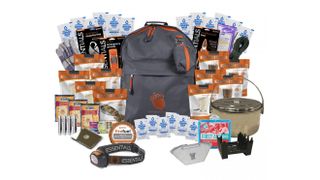Using the best emergency food storage companies can help make sure your pantry will never run empty should you be unable to get out to the food store. Whether you're stranded indoors by illness or poor weather, the services provided by emergency food storage companies can prove invaluable.
Indeed, the best emergency food storage companies will bring supplies all the way to your home, meaning you never have to step outdoors if you don’t want to. What’s more, most of the food that comes as part of an emergency food storage kit will have a use by date that extends many years into the future, particularly if you’ve requested canned or dehydrated food. Given you’ll likely keep aside what you buy for a long time, the top rated emergency food storage companies make sure the supplies they deliver are as compact as possible and won’t need to be stored in a refrigerator or freezer. Meanwhile, many emergency food storage services will also deliver fresh produce, such as vegetables, meat and fruit, if you’d prefer the option to deliver a meal from scratch, rather than out of a packet or tin. Meal plan options are common too.
If you’ve not used such a service before, our shortlist to the best emergency food storage companies is a great place to start. Alongside the company that we rate as the very best all round, you’ll also find a service that we believe delivers the biggest bang for your buck in terms of value, and another renowned for providing the tastiest food. A further company that stands out if you have special dietary requirements, are vegetarian or need gluten free products is highlighted too. And so that you have complete peace of mind, the emergency food storage companies listed have all been shown to adhere to the latest health and safety guidelines too, particularly in respect of COVID-19.
1. Wise Company: Best food storage company overall
Why you can trust Top Ten Reviews

Wise Company offers long-term and starter food kits with plenty of vegetarian, organic and gluten free options. All food is made with high-quality U.S. ingredients and the smart packaging ensures that your food will last for up to 25 years.
There's options for meats, fruit, vegetables, eggs and milk and you can even buy supplementary survival packs for your family or pets. The water options are limited and prices are higher when compared to some other options, but for high-quality and trustworthy food storage this is the company we'd recommend.
- Read our Wise Company review

2. Food Insurance: Best value food storage company

Food Insurance has nice purchase options, including a pay-as-you-go service that makes food storage more affordable upfront. That makes this company perfect for budget-conscious buyers who care about emergency preparedness. The site also has lots of sale items every time we check it, and you can use a price filter to narrow down food options to only those you can afford.
Food Insurance has tasty freeze-dried and dehydrated food you can buy in bulk or a la carte. It doesn’t carry a lot of brands, but there is good variety within the handful of brands it has. If you're on a specialty diet, you can filter results by searching the diet you're one, such as gluten-free or soy-free.
3. Thrive Life: Best tasting food storage company

Thrive Life packages its own food and sells a wide selection of tasty ingredients you can use to create your own meals. This company sells proprietary shelving that adds to the initial investment but also makes it easy to seamlessly incorporate the food into your daily menus. The shelves use gravity to make sure the oldest food is always at the front for you to use.
Thrive Life also offers a lot of recipes and ideas to ensure you cycle through its food on a regular basis. As such, you won’t even come close to the 20-year cutoff. This food is good enough to eat, not just store for an emergency.
The specialized shelving is nice but not necessary. Without it, Thrive Life's pricing is competitive. However, the company advises customers to consume their meal kits within 6 to 9 months, their To-Go bowls within 1 year, and snacks within 2 years, as these products don't last as long as the 25-year cutoff for their individual products.
- Read our Thrive Life review
4. Augason Farms: Best food storage company for dietary requirements

Augason Farms has great-tasting food options for a variety of dietary needs. All food is made in the U.S. and will last up to 25 years. There's a good selection of foods for those with dietary needs, with meat alternatives and plenty of gluten-free options.
Augason Farms sells kits which will last from 72-hours right up to one year, and these cater for one-to-twenty people. Unfortunately, you'll need to get water and water filters elsewhere, but Augason Farms has a great selection of food options.
- Read our Augason Farms review
5. BePrepared: Best food storage company for survival kits

BePrepared offers complete survival kits for pandemics, quarantine and first aid emergencies. These come with equipment, water and food options and will last for five years. You can buy food from Augason Farms on BePrepared, and it also provides its own food options. These food options don't have great options for those with dietary requirements, but shelf life is 25 years and from breakfast to energy bars, a variety of meal types are accounted for.
- Read our BePrepared review
How we evaluated
We looked at the shelf life, cost and options available for each company during our comparison. While we didn’t actually taste-test foods from each company, we judged the services by comparing the support services, food choices and product information.
Food is only one part of survival in a bad situation, so we have also reviewed emergency preparedness stores. However, for this review -- long-term food storage services -- we just focused on getting the proper nutrition in a crisis rather than everything those stores offer. We looked for the best place to buy good quality food with an exceptionally long shelf life. There are different types of companies that provide that. There are food storage companies that make and sell their own brand of food and nothing else, and the food quality is quite good from many of them. That is a fine option, but we found the all-around emergency preparedness stores offer good alternatives for food, too. They sell a range of high-quality emergency food brands in addition to many other supplies you might need.
Finding the best food storage service for you
What to Look For
Whether you opt to buy your food storage directly from the manufacturer or from an all-around preparedness retailer, the best ones make it easy to get what you really need. They take a lot of the guesswork out of the process by creating collections that make sense – three-month, six-month and one-year supplies, for example. Many also offer pay-as-you-go plans so you can spread out the cost of appropriate food storage for your household.
Pricing
Most food storage companies offer a range of one-person kits with enough food to last from only a few days to a few years. We looked at each service and noted the prices for both three-month kits and one-year kits to determine an average price range. We found that individual three-month kits start around $600 and usually go as high as $850. However, there are still some companies out there that will charge over $2,500 for the same amount of food. As expected, year-long kits are much more expensive, starting around $2,100 and going as high as $4,000. The amount and types of foods vary from service to service, but you will find that a lot of the food options are similar. When deciding which service to go with, make sure you choose your kits based on the foods that you are most comfortable with and likely to want to eat.
Food & Water
During our research of food storage services, we looked at what kinds of food and nutrition options are available. Basic food groups like meat, fruits and vegetables are valuable, as are all-inclusive entrees for the less cooking-oriented user. You should be able to expect at least 20 years of shelf life from these products, and many last even longer. The initial investment is generally significant, so we like getting at least two decades of the peace of mind that comes with having your food storage in order.
We looked for the services that offer a mixture of food types so you can plan for different types of emergencies. High-calorie bars and MREs are great for short-term catastrophes while grains and beans can get you through a longer period of unemployment, for example, or an evacuation due to natural disaster. We prefer the services that offer not just filters and chemicals for purifying water but actual water, in cans or pouches. You may or may not be near a water source of any kind in an emergency, so it is important to have some drinking water on hand, to stay hydrated and to prepare your food.
Specialty Diet
The best companies have food and dietary options that cater to meat eaters, vegetarians and people with special health requirements in their diets. Some services stick to more common foods and meat-based entrees with high caloric content. Knowing what kind of food you need for an emergency is crucial in choosing the right food storage service.
In case you have specific dietary needs, including those due to allergies, many of these services offer alternative foods. Vegetarian meals are common, and services like Thrive Life and Food Insurance offer gluten-free options. The best services make it easy to find specific food types.
Equipment & Extras
No one likes to think about devastating events that could force you to live without modern conveniences for long periods of time. It is always a possibility, though, and it makes sense to set aside some tools and supplies for being more self-sufficient. To that end, many of these stores offer seeds to start your own garden and canning or dehydrating supplies to preserve more of the food you grow.
If you buy it all at once, or even most of it at once, food storage requires a significant financial investment, and an emergency food estimator, found on the best sites, can help you determine how much food you will need to feed yourself or your family, along with the cost of everything you want to purchase. The estimator can calculate by days, months and the number of people for whom you are obtaining food.
Help & Support
Some services offer emergency education, similar to brick and mortar emergency preparedness stores. This information can offer survival tips about food and other topics. Each service should also offer phone and email for customers. Live chat is a less common but still useful way to communicate directly with companies.
The best food storage methods
There are several ways to prepare food for survival storage, and the best method depends on what you're preserving. Consider using several of these methods in your food storage plan so you have a variety of food when disaster strikes. Below, we’ve listed the most common food storage methods as well as how long they can preserve food.
Freezing - The FDA’s Refrigerator & Freezer Storage Chart helps you determine if you can freeze a food and how long it can be kept in the freezer before spoiling. For example, steak and roasts keep in the freezer for up to 12 months, making them some of the longest lasting freezer foods. That isn’t long compared to other food storage methods, but it can be helpful if you’re in a short-term pinch. You might want to consider getting a dedicated food storage freezer. Just keep in mind that should your electricity go out, frozen food will go bad rather quickly.
Drying - According to the Food Safety Hotline, drying is the oldest method of food preservation. Fruit and meat preserve really well with the help of a food dehydrator. According to Dehydrator Living, dehydrated fruit can last five to 10 years if properly stored. This is longer than canned food, which only lasts up to five years.
Smoking - Meat and fish are most often preserved using this slow cooking method. Some grills, including Char-Broil The Big Easy, double as smokers. Follow the USDA’s Smoking Meat and Poultry guidelines to ensure your food is safely prepared. The USDA states that smoked food should be used within four days if refrigerated, but it can be frozen for longer.
Canning & Bottling - You can preserve vegetables, fruit, meat, seafood, poultry and more by cooking it and sealing it in sterile bottles. As part of the canning process, you boil the food, which kills or weakens bacteria. Because of this, canned food lasts for a long time – up to five years. Once you open the bottles, the food is once again susceptible to going bad. Follow the National Center of Home Food Preservation's canning guidelines to safely can food.
Salting & Pickling - These two preparation methods are very similar. Salting removes moisture from foods and is commonly used to cure meats. Pickled food has been marinated in a saltwater solution, also called brine. You can salt or pickle a variety of foods, including seafood, meat, vegetables, fruits and eggs. According to Food Republic, pickled vegetables and fruits keep for about five to six months. Remember to refrigerate anything you pickle.
Vacuum-packing - When you remove oxygen from food, bacteria weakens and dies. VacMaster tells us that vacuum sealing preserves food three to five times longer than storing it in plastic containers and bags. Frozen vacuum-packed food lasts six to 12 months, while refrigerated food lasts one to two weeks. To learn more, check out our favorite vacuum sealers.
To learn about other food preservation methods, check out the Food Safety Hotline.
- Read our Thrive Life review



